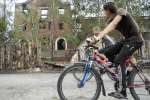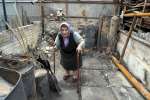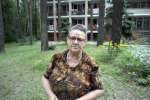- Text size
 |
|  |
|  |
| 
- Français
UNHCR delivers vital winter aid in eastern Ukraine
News Stories, 9 November 2015
KYIV, Ukraine, Nov 9 (UNHCR) – For the first time since the suspension of its activities, the UN refugee agency has delivered vital winter aid including plastic sheeting, timber and thousands of blankets for distribution to up to 12,000 highly vulnerable people in an area of eastern Ukraine that is beyond government control.
The UNHCR convoy of nine trucks loaded with basic relief items and construction materials passed through checkpoints to arrive in Luhansk on Saturday (November 7). It was the first UN convoy in three months to take supplies to the city where thousands of civilians have been caught up in the conflict that erupted last year.
The delivery included 10,000 blankets, 10,000 towels, 5,000 buckets and a similar number of jerry cans and plastic sheets, as well as cement and timber for shelter repairs. It was unloaded at a warehouse in the city for distribution in a drive that began today.
"This is a small drop in the ocean of needs we see in the conflict affected areas," Jean-Noel Wetterwald, the head of operations for UNHCR Ukraine, said. "However, with winter approaching, we hope to speed up the dispatch of humanitarian assistance to the most vulnerable civilians living in the conflict affected areas," he added.
Since the beginning of the Ukraine conflict, over two million people have been displaced within the country and abroad. Another two million people are in need of assistance in the areas which are not controlled by the government.
As winter sets in, conditions are expected to be harsher for people staying in the villages and towns close to the frontline in eastern Ukraine where the recent conflict has damaged infrastructure and housing.
With restrictions to movement, many people face insecurity and challenges in reaching medical and educational facilities. In some remote locations, access to basic services and goods remain limited, especially for the elderly and ill.
As temperatures fall across the region, shelter assistance has to be delivered fast to those living in buildings that lack windows, doors, roofs and heating. In addition, thousands of displaced people require warm blankets, winter clothing and shoes, as well as coal and heating fuels.
The convoy is the first of many planned deliveries carrying much needed winterization, domestic items and shelter materials into Luhansk. In the coming weeks, UNHCR is planning to send nearly 1,000 metric tons of humanitarian materials and emergency aid for the affected population, while considerably more resources are currently being mobilized for future dispatches in the non-government controlled territories in the east of Ukraine.





































